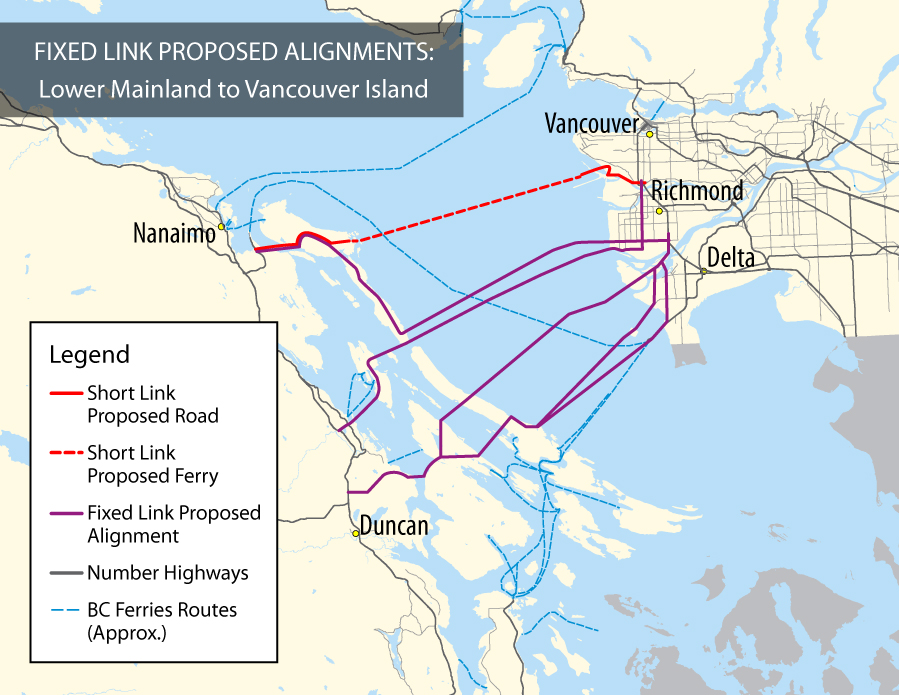Potential Fixed Link to Vancouver Island
We often get asked about the possibility of a fixed link between Vancouver Island and the Lower Mainland.
Several preliminary studies of this concept were conducted during the 1980s, however no comprehensive engineering studies have been done that confirm the feasibility of a fixed link.
The studies identified a number of potential crossing locations, connecting the Lower Mainland to the Nanaimo or Duncan areas of Vancouver Island.

Fixed Link Challenges
- Georgia Strait is located in a zone of high seismic activity.
- Potential marine slope instabilities along the eastern side of the strait could result in underwater landslides.
- Extreme wave conditions (4-7 m waves, with 6 m tides and 2-knot current)
- Wind speeds are up to 115 km with gusts up to 180 km. Closure of the structure to traffic would likely be required several times each year during strong winds.Crossing could be up to 26 km long, in depths of water up to 365 m. Deep, soft sediments are up to 450 m thick on the ocean bed.
- Major ships pass through the area and a floating bridge could not withstand the impact from such vessels.
- A bridge across the Georgia Strait would also be subject to snow, ice and fog conditions that would make driving hazardous.
Here are possible fixed-links across Georgia Strait.
Bored Tunnel
Japan’s Seikan Tunnel is 54 km in length and 240 m below sea level at its deepest point. It cost $7 billion U.S (1988 dollars) to construct and took 25 years to complete. The 50-km Chunnel between Great Britain and the European mainland cost $15 billion U.S. (1994 dollars) to construct and took 11 years to complete. The Chunnel is 75 m below sea level at its lowest point.
Construction of a bored tunnel under Georgia Strait would take place below water 365 m deep and in thick, soft sediments, creating extreme pressures during construction. The depth of both the water and the sediment would require a tunnel over 50 km in length. For these reasons, a bored tunnel is not considered a viable option.
Submerged Floating Tunnel
Submerged-floating tunnels are tubes with approximately hydrostatic equilibrium constructed deep enough below the water surface to allow uninterrupted ship passage and held in place by cables anchored to the channel bottom. No submerged-floating tunnels have ever been built, so this technology is currently unproven.
Conceptually, a submerged floating tunnel to Vancouver Island would require large gravity anchors, which would be complicated given the deep, soft soil on the ocean bed in this area. A submerged-floating tunnel would provide better passage for large vessels than a floating bridge; however it would be vulnerable to marine accidents and earthquake damage. A tunnel breach would be catastrophic and could result in the loss of many lives.
Floating Bridge
As of 2015, eleven floating highway bridges exist worldwide, but none is in water deeper than 100 m or longer than 2.3 km.
A floating bridge to Vancouver Island would require large gravity and plow-type anchors with anchor cables over 1.2 km long. This extreme length of anchor cable, coupled with the deep soft soil on the ocean bed, poses major problems. As with submerged-floating tunnels, safety is a concern. Two floating bridges have sunk during storms and the waters between Vancouver Island and the mainland are subject to wave forces more extreme than at any other existing floating bridge sites.
Cable Stayed Bridge
The other floating bridge option that has been suggested conceptualizes a series of cable-stayed spans, similar to those on the Alex Fraser Bridge. The tower piers would be supported on floating caissons tethered to the ocean bottom with cables and anchors, similar to an off-shore oil platform. This technology has not yet been applied to a fixed-bridge structure and would need considerable engineering studies in order to prove its feasibility.
Fixed-Link Comparisons
There are no fixed bridges in existence today that would meet the conditions present in Georgia Strait.
Prince Edward Island’s $1-billion (1997 dollars) Confederation Bridge is only 12.9 km long and is set in water 35 m deep with a rock bottom. In comparison, a fixed bridge across British Columbia’s Georgia Strait would be 26 km in length, in water up to 365 m deep and in a zone with much higher seismic risk.
The Tagus River Bridge in Lisbon has the deepest conventional bridge foundation in existence in water depths of only 79 m. Greece’s Rion Antirion Bridge is in an active seismic zone with an ocean bottom consisting of deep, soft sediments. However, this structure is only 2.8 km long and sits in waters of only 65 m. It cost an estimated $1940 million to complete in 2004, and each of four main pier structures cost $233 million.
Any fixed link across Georgia Strait would pass through or over high use navigation channels. Currently 45,000 vessels pass through these waters each year, including pleasure craft, commercial vessels and military vessels. A fixed link would potentially require two channels, each a minimum of 200 m wide by 65 m high to accommodate current and future vessel needs.
Private Sector Partnership
The cost of building a fixed link using the technologies available right now is estimated to be approximately $15 billion and could not be borne by government alone. Any private-sector interest undertaking such a project would require a return of 12-20%. This would have to be raised through tariffs that would not only cover the cost of construction, but also annual maintenance and rehabilitation (estimated at $90 million per year) and insurance over the 100-year expected service life of the structure
With these considerations in mind, tolls on a fixed link constructed using available technologies would be six to ten times current ferry fares.
The costs of a fixed-link construction project may not be affordable for the provincial government to undertake for many years to come. As technology advances, the ministry would be willing to look at any proposals the private sector brings forward.
Preliminary Studies
- Pre-feasibility technical studies conducted by Willis Cunliffe Tait & Co. Ltd. and Parsons Brickerhoff, Inc. and Fenco (1980)
- Pre-feasibility economic study conducted by Garth Edge International Inc. (1980)
- Preliminary environmental assessment conducted by British Columbia Ministry of Environment (1980); and
- Update to the pre-feasibility study conducted by Willis Cunliffe Tait & Co. (1985)
Contact information
Contact us if you have questions about reports or studies on B.C.'s transportation infrastructure.

